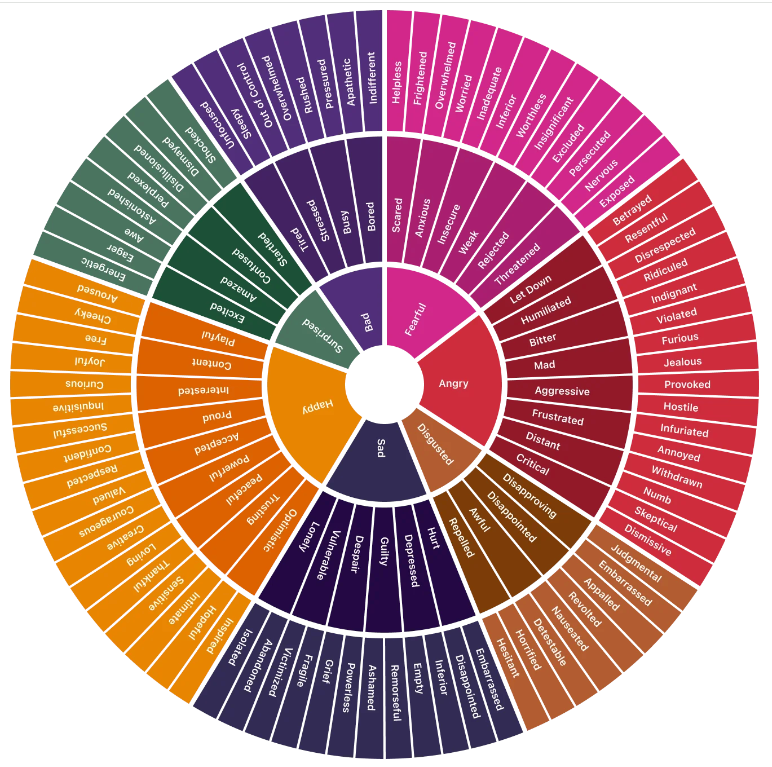How to Respond to Stressful Emotional Contagions

By Dr. Rachel Boehm,
We live in an increasingly “VUCA” (Volatile, Uncertain, Complex, Ambiguous) world. It’s easy and common to get swept up in all the feels such an environment can provoke. Fear, anxiety, overwhelm, inadequate, excluded, rejected, weak, critical, mad, cynical, tired, busy, apathetic, horrified, hesitant… really an entire half of the Feelings Wheel.

One reason it’s so easy to get swept up in the feels is that emotions are contagious. And there are lots of emotions out there. Another is because we humans are hardwired to experience emotions. Emotions developed as a survival system to help us respond quickly and effectively to whatever is happening around us (Simic et al., 2021). Instead of relying solely on automatic reflexes, emotions allow the brain to interpret a situation, choose the best course of action from the context, and to learn from those experiences to inform our next choices.
Fear and anger, for example, prepare the body to face or escape danger, while joy and affection encourage connection and cooperation, a sense of belonging that's a fundamental human need. Over time, our brain’s emotional response system became essential not only for survival but also for learning, decision-making, and building the social bonds that allowed humans to thrive.
This is also why emotions are contagious. This mirroring served key functions for early humans, such as allowing us to respond collectively to danger before each individual was fully aware of the threat, strengthening trust and social bonds for effective teamwork and caregiving, and improving nonverbal communication. The mirroring or automatic mimicry of emotion contagion helped us survive and thrive in groups.
The problem now, of course, is that we are constantly flooded by emotional signals from every direction, for example face-to-face, through media, social networks, and even remote work platforms. In a high-stress, VUCA environment, negative emotions like anxiety, frustration, fear, sadness, and stress can spread just as easily as positive ones, often amplifying individual and group distress, eroding psychological safety and resilience, decreasing hope and increasing cynicism, and making it harder to think clearly or make sound decisions.

The increased speed and volume of emotional contagion today can quickly escalate emotional exhaustion and collective burnout, making it vital to understand and manage our individual and shared emotional landscape if we want to maintain wellbeing, resilience, and healthy collaboration in modern life.
Here's how you can start:
- Build strategic self-awareness. Learn how positive and negative emotions affect you. We all change how we think, feel, and behave under pressure. This can turn even our greatest strengths into liabilities impacting how we interpret situations, others, and ourselves. Our reputation can take a hit as a result. Get curious about how you respond physically, mentally, and emotionally to various stressors.
- Recognize how others impact you. How do the emotions of others affect your own? Are the emotions of some more contagious than those of others? Probably. Get curious about how different people influence your thoughts, feelings, and actions. And then…
- Set boundaries. Put limits on what media you let in, when, and how much. Same with people. Are there some people you need to take a step back from, or interact with less often to protect your energy and focus? Setting boundaries isn’t about pushing people away; it’s about honoring your needs and values so you can show up as your best self.
- Take control. Focus on what you can control, which sometimes is limited to your attitude and where you put your attention. Look for the lessons, look for the simple steps. You cannot control everything that happens to you or around you, but you can control how you respond. It isn’t easy, but it's worth continually striving to get better at it.
- Get present. There is a lot of talk about mindfulness, and rightly so. Among other benefits, mindfulness helps reduce stress, improve emotional regulation, and enhances overall wellbeing by keeping attention focused on the present moment without judgment. There are many ways to strengthen your skill at mindfulness. A simple one is to “take the first thing.” Whenever you're feeling distracted by a thought or feeling, help yourself come back to the present by noticing and naming the first thing you notice around you. It can be a sight, smell, sound, anything. Keep naming until you feel like you've returned to the solace of the present.
- Quiet the “head trash.” When you notice yourself spinning, so to speak, you can ask yourself a few questions: What am I feeling? Why, what happened? What’s the story I'm telling myself about what happened to drive these feelings? How true or helpful is this story? Is there another way to look at it? What is more likely true? What can I control here? And then, take action on what you can control.


Dr. Rachel Boehm is a resident of West Falls Church. She’s lived in the area for over 15 years and runs a modern change management firm helping leaders and employers navigate business transitions and constant busyness with less tension for more successful outcomes. Dr. Rachel holds a PhD in psychology focused on individual and organizational behavior.




Member discussion